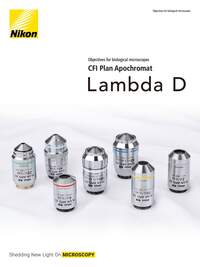- en Change Region
- Global Site
Capture Every Detail of Biological Phenomena
Microscopic imaging continues to rapidly evolve together with such advances in digital technology as confocal microscopes and high-sensitivity, large field-of-view CMOS cameras. The newly developed CFI Plan Apochromat Lambda D is a high-performance objective series optimized for digital solutions that are essential for future life science research.
The Lambda D series objectives deliver high image quality across the large field of view of 25 mm and chromatic aberration correction over a wide wavelength range. They improve the accuracy of quantitative analysis and realize highly reliable data acquisition.
Key Features
Bright and Clear over a Large Field of View
Since excellent image quality is obtained up to the edge of the 25 mm diagonal FOV, imaging throughput is improved.
Image flatness has been improved by adopting a newly-developed high-refractive index glass and correcting field curvature in the oil immersion objectives. Bright and clear images can be obtained right up to the edge of the 25 mm field of view.
This results in:
- Improvement accuracy of light intensity measurement
- Generation of seamless macro images in a short time
- Acquisition of a wide range of life phenomena with a single image
- Enhancement of high-content screening throughput
Reduced light intensity deterioration at the periphery of the field of view
With conventional objective
With Lambda D objective
BPAE cells; Label: GFP, MitoTracker Red, DAPI; Microscope: AX R; Objective: CFI Plan Apochromat Lambda D 60X Oil
The Lambda D series objectives minimize light intensity deterioration at the periphery of the field of view. This allows (DAPI stained) cell nuclei at the edges of the image to be observed brightly, even with confocal imaging.
High-precision image stitching
Mouse kidney; Label: Alexa 488 WGA, Alexa 568 Phalloidin, DAPI; Camera: DS-Qi2; Objective: CFI Plan Apochromat Lambda D 10X
Since image acquisition time can be reduced thanks to a large 25 mm diagonal field of view and superior image quality up to the image periphery, seamless, high-quality stitched images can be efficiently obtained.
Large FOV enhances imaging efficiency
A 25 mm FOV is 30% more efficient than a 22 mm FOV because it requires less images for image stitching.
High refractive index glass achieves uniform brightness and image quality
The Lambda D series employs glass with a high refractive index as the material for the front lens at the head of the oil immersion objective to correct field curvature.
By adopting glass with a higher refractive index than that of the G1 lens for the G2 lens, the Petzval sum of the entire objective is reduced, and image flatness and performance at the periphery of the field of view are improved.
Accurate Data Acquisition in All Wavelengths
One objective supports fluorescent dyes with a wide range of wavelengths, from ultraviolet to near infrared.
Extra-low dispersion glass has been employed as a lens material, simultaneously correcting chromatic aberration over a wide wavelength range of 405 nm to 850 nm. Since deviation of the image plane for each wavelength is imperceptible, high-precision multicolor imaging is enhanced.
Highly reliable quantitative data can be obtained when measuring the light intensity of nuclear stains.
Extra-low dispersion glass corrects chromatic aberration
Using glass with low dispersion characteristics corrects chromatic aberration from 405 nm.
Image formation positions of different wavelengths can be corrected using extra-low dispersion glass.
The Endless Pursuit of High Resolution
Using technology that processes the edge of lens elements to the minimum thickness, Nikon has maximized the use of the light rays that pass through the periphery of the lens diameter to increase numerical aperture, delivering high resolution of fine structures.
A clear fluorescent image with a high S/N ratio can be obtained.
Mouse intestine; Label: Alexa 488, Alexa 633, Microscope: AX R; Objective: CFI Plan Apochromat Lambda D 100X Oil
Mouse cerebral nerve (MIP); Label: GFP; Z range: 165.5 μm; Z step: 0.147 μm; Microscope: AX R; Objective: CFI Plan Apochromat Lambda D 100X Oil
High resolution images can be captured with a large field of view.
Gastric wall; Label: SMA antibody staining; Camera: Digital Sight 10; Objective: CFI Plan Apochromat Lambda D 40XC; Image courtesy of Nichirei Biosciences Inc.
Edge thinning technology that achieves high resolution
The edge thickness of each of the lens elements is processed to be as thin as possible to expand each element’s effective diameter.
By enlarging the effective diameter of the lens, light beams with larger divergence angles emitted from objects can be captured, improving the numerical aperture.
Anti-Reflective Nano Crystal Coat
Nano Crystal Coat is ultra-low refractive index thin film technology that applies a nanoparticle film used for the projection lens of Nikon’s semiconductor manufacturing equipment. An extremely high antireflection effect is achieved by forming a low-density film with particles of a few nanometers to a dozen nanometers. It also lowers the reflection of vertically incident light compared to conventional antireflection film, achieves extremely high transmittance in a wide wavelength range, has an unprecedented effect with respect to ghosting and flares caused by obliquely incident light.
| Conventional anti-reflection multi-layer film | Nano Crystal Coat |

| Conventional multi-layer film | Nano Crystal Coat |

